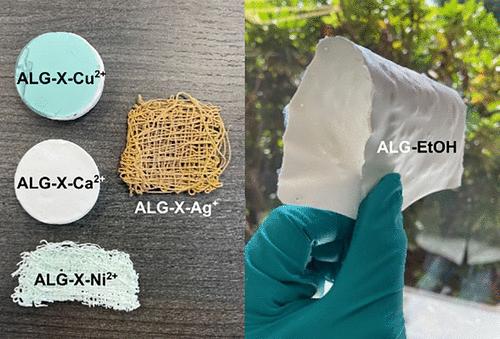Form-Factor Control of Alginate Aerogels Via Thixotropic Sols: From Monoliths to Fibers to Films
IF 8.2
2区 材料科学
Q1 MATERIALS SCIENCE, MULTIDISCIPLINARY
引用次数: 0
Abstract
Producing homogeneous alginate aerogel monoliths is challenging due to the uncontrollably fast gelation of sodium alginate (NaALG) solutions, which is typically induced with metal ions. This issue is overcome by decoupling molding from gelation. Aqueous NaALG solutions are first converted into thixotropic liquids via in situ acidification with acetic acid (AcOH) generated gradually through the hydrolysis of acetic anhydride (Ac2O), thus, providing time for casting in molds. The resulting solid-like thixotropic liquids are rigidized into wet gels conforming to the molds by a membraneless dialysis process via nonsolvent-induced phase separation, treatment with strong acids (HCl), or aqueous metal ion solutions (Ca2+, Cu2+, Fe3+, Ni2+, Ag+, Au3+). The thixotropic nature of the NaALG/Ac2O mixtures enables extrusion into fibers or spreading into films, followed by rigidization using the same methods. Wet gels in monolithic, fibrous, or film form were dried into aerogels with supercritical fluid (SCF) CO2. All aerogels were characterized by SEM, N2-sorption porosimetry, IR spectroscopy, solid-state CP MAS 13C NMR, and elemental analysis. Oscillatory rheology tracked the transition of NaALG to thixotropic liquids during Ac2O and AcOH titrations run in parallel. Thixotropic liquids from both titrations were rigidized with the nonsolvent-induced phase separation method and were processed into aerogels establishing that AcOH from the hydrolysis of Ac2O converts up to ∼30% mol/mol of NaALG to alginic acid (ALGH). Conversion of the remaining NaALG in thixotropic liquids to ALGH (>95% mol/mol) requires a strong acid (HCl), while rigidization with metal ions just replaces residual Na. Dynamic mechanical analysis (DMA) showed nearly identical storage moduli (E′) for wet gels and aerogels, confirming that the solid network is formed during the rigidization step and is unaffected by subsequent processing. Notably, elemental analysis, porosimetry, and DMA data indicated that gels rigidized with Fe3+ included a secondary network, which, based on literature Mössbauer reports, is assigned to sol–gel-derived iron oxide.

通过触变溶胶对藻酸盐气凝胶的形状因子控制:从单体到纤维到薄膜
由于海藻酸钠(NaALG)溶液的不可控快速凝胶化,通常是由金属离子诱导的,因此生产均匀的海藻酸盐气凝胶单体具有挑战性。通过将成型与凝胶分离,可以克服这个问题。NaALG水溶液首先通过乙酸酐(Ac2O)水解逐渐产生的乙酸(AcOH)原位酸化转化为触变液体,从而为模具铸造提供时间。通过非溶剂诱导相分离、强酸(HCl)或水金属离子溶液(Ca2+、Cu2+、Fe3+、Ni2+、Ag+、Au3+)处理,得到的固体样触变液体通过无膜透析过程固化成符合模具的湿凝胶。NaALG/Ac2O混合物的触变特性使其能够挤压成纤维或扩散成薄膜,然后使用相同的方法进行固化。湿凝胶在整体,纤维,或薄膜形式干燥成气凝胶与超临界流体(SCF) CO2。采用扫描电镜、氮气吸附孔隙度法、红外光谱、固态CP MAS 13C NMR和元素分析对气凝胶进行了表征。振荡流变学追踪了在Ac2O和AcOH平行滴定过程中NaALG向触变液体的转变。用非溶剂诱导相分离法将两种滴定的触变液体固化,并加工成气凝胶,证明Ac2O水解产生的AcOH可将高达30% mol/mol的NaALG转化为海藻酸(ALGH)。触变液体中剩余NaALG转化为ALGH (>95% mol/mol)需要强酸(HCl),而金属离子固化仅取代剩余Na。动态力学分析(DMA)表明,湿凝胶和气凝胶的存储模量(E’)几乎相同,这证实了固体网络是在固化阶段形成的,不受后续处理的影响。值得注意的是,元素分析、孔隙率测定和DMA数据表明,用Fe3+固化的凝胶包括一个二级网络,根据文献Mössbauer报告,该网络被分配给溶胶-凝胶衍生的氧化铁。
本文章由计算机程序翻译,如有差异,请以英文原文为准。
求助全文
约1分钟内获得全文
求助全文
来源期刊

ACS Applied Materials & Interfaces
工程技术-材料科学:综合
CiteScore
16.00
自引率
6.30%
发文量
4978
审稿时长
1.8 months
期刊介绍:
ACS Applied Materials & Interfaces is a leading interdisciplinary journal that brings together chemists, engineers, physicists, and biologists to explore the development and utilization of newly-discovered materials and interfacial processes for specific applications. Our journal has experienced remarkable growth since its establishment in 2009, both in terms of the number of articles published and the impact of the research showcased. We are proud to foster a truly global community, with the majority of published articles originating from outside the United States, reflecting the rapid growth of applied research worldwide.
 求助内容:
求助内容: 应助结果提醒方式:
应助结果提醒方式:


